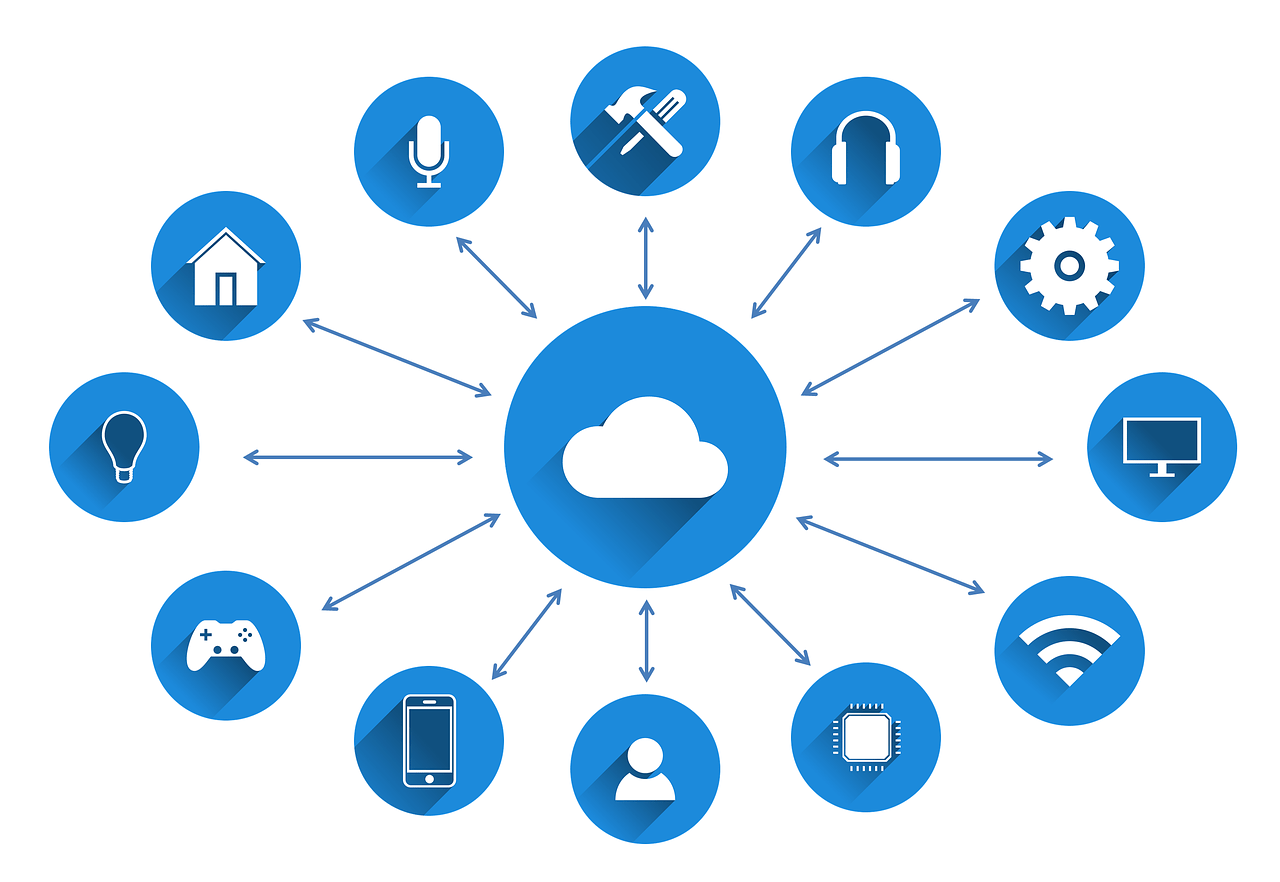Posted by: Aubrey Felix on August 30, 2023 at 8:22 am

Image by Gerd Altmann from Pixabay
Computing in the Cloud
Imagine if you could store your favorite photos, work files, or business data in a space that you could access anytime, from anywhere. Well, that’s what “Computing in the Cloud” is all about! It’s like a digital locker where both everyday folks and big businesses can keep their stuff safely. Thanks to this fantastic innovation, we no longer need bulky hard drives or stacks of CDs. The cloud has made life simpler, especially in a world where we’re always on the go. And the best part? Industries from healthcare to movies are using it to offer us better services. Let’s dive in and learn more about this tech wonder!
In this Article:
- Brief History of Cloud Computing
- Benefits of “Computing in the Cloud”
- Common Cloud Service Models – (IaaS, PaaS, SaaS)
- How Cloud Computing Transforms Industries
- Future Prospects
- Challenges and Concerns of “Computing in the Cloud”
Brief History of Cloud Computing
Navigating through the timeline of technological advancement, cloud computing stands out as a star player, lighting up the path of our digital evolution. But where did it all begin? Let’s hop into our virtual time machine and take a jaunt back through the decades to see how this transformative tech phenomenon took shape.
Origins of Computing in the Cloud
Our journey begins in the swinging 1960s, a time of innovation and exploration. Among the pioneers of the era, J.C.R. Licklider stands out. Playing a pivotal role in the development of the ARPANET, the precursor to our modern internet, Licklider wasn’t just laying groundwork; he was dreaming big. He envisioned a future with globally interconnected systems, where data and software weren’t bound by physical constraints. Sounds familiar, right? That’s because his dream laid the foundational thoughts for what we today recognize as cloud computing. Imagine that: a world where, no matter where you were, a wealth of data was at your fingertips.
Milestones in Development
- 1990s: Fast forward to the dawn of the digital age, and we find ourselves in a world brimming with possibilities. The term “cloud computing” wasn’t just a phrase floating around; it began to gain solid shape. And one crucial development in this decade? The rise of VPN services. They may seem like a modest start, but these virtual private networks were the tentative baby steps towards a more interconnected digital ecosystem.
- 2000s: Hold onto your hats, because this is where the real acceleration begins. The early part of this millennium witnessed Amazon Web Services (AWS) introducing the Elastic Compute Cloud (EC2) in 2006. It was nothing short of revolutionary. Gone were the days when developers were restricted by their local machines. With EC2, they had the power to operate applications on a rented infrastructure, marking a game-changing moment in the journey of cloud computing.
- 2010s: Picture a garden in springtime, with flowers blossoming left, right, and center. That’s the 2010s for cloud computing. Tech behemoths like Google, Microsoft, and IBM weren’t just spectators; they were keen participants, diving headfirst into the cloud arena. The result? A flourishing ecosystem of services, apps, and platforms that transformed the cloud from a technical luxury to an everyday essential.
- 2020s: The 2020s ushered in an era where computing in the cloud became a lifeline, driven by global shifts towards remote work due to challenges like the pandemic. This decade highlighted the cloud’s role in collaboration tools and emphasized its scalability during times of immense digital reliance. There’s been a notable shift towards hybrid and multi-cloud solutions, and the fusion of cloud technologies with AI has paved the way for smarter data analytics. Simultaneously, the cloud industry is making strides in sustainability and exploring synergies with emerging technologies like quantum computing and 5G networks.
Benefits of “Computing in the Cloud”
Cost Efficiency
Let’s talk savings! Picture this: Instead of buying a costly oven and baking bread from scratch every day, you decide to get fresh loaves from a bakery at a fraction of the price. That’s similar to the beauty of cloud computing. Instead of spending big bucks on heavy-duty hardware, businesses can ‘rent’ space in the cloud, saving a tidy sum upfront. But the savings don’t stop there.
Imagine having a team that no longer needs to roll up their sleeves and tinker with complex hardware setups. That’s right! With the cloud, IT folks can wave goodbye to those long hours of setting up and maintaining systems. Plus, think about the joy of automatic software updates. No more manual checking and updating. The cloud takes care of it. All these efficiencies not only save money but also precious time. In the grand scheme of things, it’s about getting more done with less, making operations smoother, and keeping the focus on what truly matters. In the business world, that’s a win-win!
Scalability
Think of the cloud as an elastic band – it stretches as you need it to. If you’ve ever thrown a party and weren’t sure how many guests would show up, you’ll understand the value of being prepared for anything. That’s what cloud scalability offers! For young start-ups, picture launching a new website and getting way more visitors than expected – it’s like the whole town showed up to the party. Or, for a big multinational, imagine expanding to new regions, similar to throwing multiple parties across different cities. The cloud ensures that, no matter the number of guests or where they’re from, there’s always enough space and resources to host them comfortably. This adaptability, all happening in real-time, means everyone gets excellent service, and no one feels left out. It’s the digital way of ensuring there’s always room for one more at the party!
Collaboration Capabilities
Cloud computing hasn’t just removed geographical barriers; it has redefined what collaborative effort looks like in the modern world. Cloud-based platforms, such as Google Workspace, Microsoft Teams, and Slack, have become the linchpins of global collaboration. They allow for simultaneous document editing, real-time feedback, video conferencing, and a plethora of other synchronized activities. The cloud ensures that all members have access to the same data, the same tools, and the latest updates. It’s no longer just about sharing files; it’s about real-time communication, instant feedback, and a cohesive team experience no matter where each individual is located.
Cloud Disaster Recovery
One of the unsung heroes of cloud computing is its capability for disaster recovery. For small businesses, a natural disaster could be catastrophic, leading to data loss that might never be recovered. Traditional backup methods, such as external hard drives or off-site backups, can be costly and may not always be effective, especially if they too are damaged in the disaster. Cloud computing offers a lifeline. By storing data in the cloud, businesses ensure that their information is housed in multiple locations, often spread across various geographical regions. This decentralization means that even if one data center faces an outage or is affected by a natural disaster, the data remains accessible and safe in another. As a result, businesses can resume operations rapidly, minimizing downtime and financial loss. For a small enterprise, this quick recovery can be the difference between continuity and closing doors.
Common Cloud Service Models
Infrastructure as a Service (IaaS)
Think of IaaS as the foundation of a house. Here, users lay their customized structure on a rented foundation. This model provides a high degree of flexibility and control over the infrastructure, but also demands a deeper understanding of resource management.
Platform as a Service (PaaS)
PaaS can be seen as the walls and basic interior of the house. While the underlying infrastructure is hidden, developers get an environment where they can deploy applications without worrying about the nitty-gritty of infrastructure management.
Software as a Service (SaaS)
SaaS is like a fully furnished apartment. Users simply step in and use the software. It’s user-friendly, requires minimal technical know-how, and is incredibly popular among businesses due to its straightforwardness.
How Cloud Computing Transforms Industries
Healthcare
Imagine that your doctor, no matter where they are, can instantly pull up your medical history with a few clicks, ensuring you get the best care, every time. That’s the beauty of combining healthcare with cloud computing. The journey towards a more digital and accessible healthcare system has found a trusty sidekick in the cloud. It’s not just about storing records safely; it’s akin to having a vast library where every patient’s story is carefully catalogued.
But wait, there’s more! Beyond just storing data, the cloud wears the hat of a brilliant detective. It helps healthcare professionals spot patterns, make predictions, and understand health trends. Picture this: before you even realize you’re falling into a health pitfall, the cloud’s analytical prowess might help doctors pinpoint potential issues and advise corrective action. It’s like having a super-smart health assistant that’s always looking out for you. In this age, where proactive healthcare is the goal, cloud computing proves to be an invaluable ally, paving the way for brighter, healthier futures for everyone.
Finance
In today’s financial landscape, staying ahead is paramount. This is where the fusion of finance and cloud computing shines. Ever wondered how financial gurus make instant decisions or how banks swiftly detect unusual activities? That’s the cloud working its magic. Picture the vast network of financial data like a complex web. The cloud, acting as a sharp-minded analyst, swiftly decodes this web, offering timely insights, identifying potential frauds, and assisting in swift market trades. It’s akin to a digital tool granting a clear view into financial future trends.
Moreover, the emergence of digital-only banks, allowing us to manage finances at our fingertips, is powered by the cloud. These modern banks embrace the agility of cloud technology, catering to today’s tech-savvy users. Every time you use your banking app or admire prompt fraud detection, remember the cloud’s pivotal role in that efficiency.
Education
Not so long ago, if you wanted to learn from top-notch universities or leading experts, you’d probably have to pack your bags, hop on a plane, and invest a small fortune. But thanks to the marvel of cloud technology, the landscape of education has undergone a revolutionary transformation. Beyond the realms of virtual classrooms, which have made distance learning an everyday reality, the cloud’s magic touch has made quality education accessible to all.
Enter Massive Open Online Courses, better known as MOOCs. These amazing platforms, comfortably residing on the cloud, have flung wide the doors of world-renowned education institutions. No matter where you are, if you have an internet connection, top-tier learning experiences are just a click away. And it’s not just about watching lectures; you can participate in discussions, complete assignments, and even earn certificates, all from the comfort of your home!
The beauty of it all? Whether you’re a curious teenager, a working professional looking to upskill, or even a retiree with a passion for learning, the cloud-based education world welcomes you with open arms. In essence, the cloud has played a part in ensuring everyone gets a fair shot at premium learning opportunities. So, next time you dive into an online course or attend a virtual class, take a moment to appreciate the cloud’s role in making it all possible!
Future Prospects

Image by Gerd Altmann from Pixabay
Innovations on the Horizon
Let’s embark on a small tech journey, shall we? Imagine standing on the edge of a vast technological horizon, witnessing the dawn of a new era. Here, we’re introduced to a concept known as ‘edge computing’. It sounds like something out of a sci-fi novel, doesn’t it? But it’s very much our present and future. In simple terms, edge computing is all about performing computations right where the data originates, be it your smart fridge, wearable health device, or even a traffic sensor on a busy intersection.
Now, why is this so revolutionary? Picture you’re at a concert streaming live video. With traditional systems, there’s a tiny but noticeable delay, or ‘latency’, as data travels far and wide for processing. But with edge computing, this delay virtually vanishes, as most of the action happens right there on your device, leading to an almost instantaneous experience. And here’s where things get even more exciting. By combining this edge computing with the vastness and versatility of the cloud, we’re on the brink of achieving faster, smarter, and more efficient digital systems.
Moreover, this fusion promises to redefine our digital experiences, making them more seamless and intuitive. As we continue to integrate smart devices into our daily lives, from our homes to our workplaces, this blend of edge and cloud computing will play a pivotal role in shaping a smarter, more connected future. So, there’s a lot to be excited about on the horizon!
Challenges and Concerns of “Computing in the Cloud”
Data Security
Ah, the concern of security in our digital age. Imagine storing all your precious belongings in a vault – you’d want that vault to be virtually impenetrable, right? The cloud is somewhat like that virtual vault for our data, and as with all treasure chests, it’s crucial to keep it safe. While instances of cloud breaches may be fewer when compared to other systems, when they do happen, the sheer volume of data potentially exposed can be staggering. Think about it: it’s not just one individual’s data; it can be information from thousands, if not millions, of users.
So, what’s the solution? It’s a bit like adding multiple layers of security around our precious vault. Companies are pouring resources into advanced encryption techniques, ensuring that data, when intercepted, remains a jumble of incomprehensible codes. Additionally, top-notch intrusion detection systems act as vigilant watchmen, always on the lookout for suspicious activities and potential threats. The message is clear: in the world of cloud computing, security isn’t just an option; it’s an absolute necessity.
Privacy Issues

Image by Darwin Laganzon from Pixabay
Navigating the digital seas of data is no small feat, especially when you have to consider the varying global regulations. Data, once stored in the cloud, often doesn’t recognize borders. It’s scattered across continents, making it tricky when it comes to privacy regulations.
For instance, there’s the General Data Protection Regulation (GDPR) in Europe, a stringent set of rules ensuring data privacy. But the catch? Each region, each country might have its own set of guidelines. It’s a bit like trying to follow multiple rulebooks while playing a single game! For businesses, this becomes a delicate balance – how do you ensure compliance with European laws while also meeting the different requirements in Asia, the Americas, or Africa?
It’s akin to a global jigsaw puzzle where every piece represents a different regulation. Assembling it requires diligence, awareness, and often, a team of experts making sure businesses strike the right balance. As we head further into the digital age, mastering this balancing act will be crucial for companies operating in the cloud.
Computing in the Cloud – Conclusion
Stepping back and taking a broad view, the journey of “Computing in the Cloud” feels a bit like watching a city skyline gradually light up as night falls. It’s vast, dynamic, and ever-evolving. This technological marvel isn’t just about storing data or running applications; it’s about transforming the very fabric of how we operate, communicate, and innovate. With its unmatched blend of flexibility, efficiency, and global accessibility, computing in the cloud is truly redefining boundaries.
But like any sprawling metropolis, the world of cloud computing isn’t without its complexities. As we look ahead, there will undoubtedly be challenges to navigate—be it security concerns, privacy regulations, or adapting to new innovations. Yet, with every hurdle, there’s an opportunity to refine, improve, and advance.
In essence, the cloud isn’t just a fleeting tech trend. It’s a testament to human ingenuity. As we continue our digital journey, “Computing in the Cloud” stands tall, not just as a tool, but as a beacon—illuminating a future where our world is more interconnected, efficient, and driven by the boundless possibilities of data. So, as we embrace this promising horizon, one thing is clear: the sky’s the limit when it comes to the potential of cloud computing!
Would you like to move your small business to the cloud? Contact us today to discuss how TAZ Networks can help you.

